Menus
- The sports tractor
- Discovery
- In the saddle
- In the city
- On the road
- On the highway
- Road holding, suspensions
- Braking
- Duo
- Convenient
- Conclusion
The sports tractor
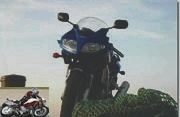 Presented
Presented
at Intermot 2002, the SV 1000 is the descendant of the deceased
TL 1000S, born itself in 1996: a sporty twin of 1000
cm3 with a dantesque torque of 10 mkg: enough to give vibrations
sporty to the most jaded of bikers.
It flirts with the fashion of 1000 cm3 all categories and offers
on paper, a logical continuation of the twins available in the 650 cm3 version.
On paper only? Verdict after four days of testing
on the Normandy coast…
Discovery
 All
All
the 2002 vintage SV have the same profile: a tubular frame
in aluminum with sharp angles, a sharp double frontal optic
and a gigantic LED tail light! From the front, the SV
has a certain family resemblance with the Fazer 1000. This is their only point
common. The 1000 retains the two-stage saddle, a characteristic feature
of its younger sister 650. In its S version, for Sportive, we notice
immediately the half-handlebars.
The Pilot Sport 180 / RR fit confirms the model’s claims.
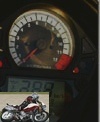 At
At
dashboard, identical on all SV models, we notice
first, the prominent tachometer, with a red zone at
11,000 turns. This overlaps a complete digital dial offering: tachometer,
totalizer, partial double trip, clock, engine temperature.
The essential indicators complete the whole: on the right, the
indicator light of passage in reserve and full headlight,
left, neutral, the oil warning light, and the indicators / warning.
The saddle is relatively high, and the feet are just touching the ground on
the point for the pilot of 1.70 m.
The mirrors are then adjusted particularly
easy and precise. They will simply be blamed for an angle of vision
reduced.
In the saddle
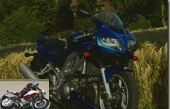 Contact
Contact
! The front double optic lights up automatically …
do not forget to switch off the ignition during discussions. No starter,
injection requires … the bi snorts with a serious sound. The bust
bends forward to catch the half-handlebars, but less
than on a sports car. The footrests rather high and slightly
setbacks confirm a sport-like position.
The first engages gently and the first kick in the ass
is given here, followed by a second, then a third, to
each gear shift. And as long as we forget the use of the clutch,
successive kicks follow one another, punctuated by
the hoarse rumblings of the exhaust.
It’s manly, it has character but it takes
really very easily in hand, without any – bad – surprises.
In the city
 The
The
motorcycle leaves on a trickle of gas, even if the omnipresent twin,
remind all plans that this is a big, very
big twin-cylinder: that slap and that regular poum-poum
punctuates the sequences between the cars.
The first laps of the wheels in town turn out to be pleasant.
The OAS steers easily, although it is not the liveliness
of a roadster or its little sister 650.
If the engine warms up quickly – and exceeds
quickly 100 ° c – the heat released is not
feel at the pilot level. On the other hand, the passenger will quickly feel his
boiling feet, the fault coming back to the licking exhausts
the footrests.
 the
the
mill agrees to climb high in the towers without screaming, even if
the vibrations are clearly felt beyond the eight thousand
revolutions / min. Pleasant point, the vibrations are not felt
in the mirrors which remain clear. The first can
to shoot thus up to 100 km / h and the second up to 140
km / h !
In short, in town, we will easily stay in first or second,
and in rare cases in third. The box reveals itself
pleasant and completely forgotten.
On the road
The SV quickly finds its marks and the twin can finally give
of voice. Hollows below 4000 rpm, the twin begins to
tow very seriously past this limit and send
really from 6,500 rpm and up to 8,000 rpm.
Then the thrust becomes linear.
It never gives the violence / power of a sportswoman, but in passing,
this proves that it is very very effective, including in duo.
And the difference between impressions felt and reality / efficiency
appears important here. In the end, this results in a motorcycle that is easy to
take in hand and yet allows to light on the road.
On the highway
 The
The
SV commits without apprehension. No need to hide behind
the bubble, the SV quickly takes its turns. At only 6,000 rpm,
the SV is already at 160 km / h and far from the zone
Red. The comfort limit is around 180 km / h; It is
then time for the pilot to find a little shelter behind the
bubble. The slight stresses on the handle allow
to feel that the bike still has a lot of leeway to continue
on its way at speeds that have become largely prohibited.
Road holding, suspensions
Road holding is impeccable. Souvenir of the TL 1000S,
recalled by the almost concealed steering damper
up front, the SV 1000S is unperturbed, unsurprisingly. She is signing up
naturally curved with little effort, and does not break apart,
even in duet and on bad coating. At unreasonable speed
and entering a curve too quickly, it turns out to be a
chouilla under tack.
The original settings are firm, but never transform
the motorcycle at the end of the wood. The first kilometers on bad surfaces
and the dry reactions of the suspensions made me
fear the worst. But in the end, the two hundred kilometer stages
swallow in less time than it takes to say it without any pain,
neither for the pilot nor for the passenger. Hence the interest
to go beyond first impressions and kilometers.
 Braking
Braking
The rear turns out to be an honest retarder,
rather soft.
On the other hand, the front brake is a real treat. He offers
an excellent feeling, an extraordinary bite and allows you to really
dose braking with two fingers, no surprises or need to grip
the lever.
Duo
 The
The
double saddle offers the duo and we tell ourselves that the passenger will be here at
the same sign as on a sports car but it is not! This
will be a real surprise. In fact, the position slightly
above the pilot, but not too much, offers a double advantage: to offer
a vision above the pilot’s head, and thanks to the
efficient bubble, never suffer from the wind, and this up to 180 km / h.
Afterwards, the passenger will hide as best he can behind the
driver so as not to feel too much the effects of speed. Corn
compared to a sports car, the passenger finds his happiness here.
In the end, it seems that the SV is one of the best sporting compromises
for the passenger.
Convenient
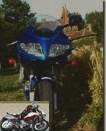 The
The
place under the saddle offers the possibility of placing a huge and
large U, plus the tool kit … a 33cl drink and a guide.
It’s not bizarre, but it’s more than the usual standards.
The SV does not offer a center stand, but a kickstand
lateral offering good support. A large lug allows you to store
easily the crutch; on the other hand, the maneuver in the other direction
turns out to be a bit difficult and unfolding it is rather
in two steps and three movements.
The tank allows you to put a magnetic bag,
limited size. Indeed, the low position prevents having
a two-tier satchel on pain of no longer being able to
catch the half-handlebars.
Consumption during the test
I thought the gauge had a problem when I saw the witness
of passage in reserve ignite at 180 km / h, whereas I had
started leek while driving. Indeed, with a consumption
minimum of 6.2 liters per hundred and a small tank of only
17 liters, the passage takes place very early, too early. Too bad for
a motorcycle that reveals unexpected capabilities of
road.
Mini: 6.2 l. – Maxi: 8 l – autonomy before reserve: 180 km
Conclusion
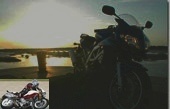 The
The
SV 1000S is a motorcycle that surprises. We expect a sporty twin
and we would almost find a sporty GT that ignores itself. Almost comfortable
on long journeys for the pilot and the passenger, it really allows
to go far without fatigue for this type of motorcycle.
Of a rather playful character on departmental, she
is not stingy with sensations, quite the contrary. She will gladly give
fun for all pilots, even the less experienced but
will leave thrill seekers a little hungry.
In short, it is an easily accessible motorcycle for all owners
of 600 who would like to switch to a 1000 cm3 but hesitate
to take the step: they can do it without any hesitation
with the SV 1000S, especially since the bike is appreciated more
more over the kilometers. A heart – big like that – to
take and who will return it to you.
Strong points
- motor character
- braking
- comfort, pilot and passenger
- protection
Weak points
- autonomy (<200 km)
Competitors: Yamaha FZS 1000 Fazer,
The technical sheet |
Your reactions on the forum
Related articles
-
2007 Kawasaki Z1000 motorcycle test
Five-day test of the 2007 vintage roadster The Kawasaki Z1000 released in 2003 was well received but mixed: a look of hell but an engine considered like…
-
Kawasaki Z1000 motorcycle test
The Kawasaki Z1000 represents the master stroke of the Akashi manufacturer. Used to its sporting tradition, Kawasaki was rather discreet if not…
-
Kawasaki Z 750 motorcycle test
Cure of youth After a big success and more than 62,000 models sold, the Kawasaki Z750 evolves only 3 years later its output: engine, chassis and design….
-
Suzuki SV 650 N motorcycle test
The bi-jou-et The SV is the youngest in the roadster family at Suzuki. Upon arrival, she began to capsize hearts by offering a twin cylinder vitaminized…
-
Triumph Sprint ST 1050 motorcycle test
Test over 5 days and 1,000 km. Discovery The Sprint ST has been completely revised for its edition 2005, both in terms of aesthetics and chassis and…
-
Honda CMX 500 Rebel S motorcycle test
Little rebellious bobber In-line twin, 471 cm3, 45 hp at 8,500 rpm, 44.6 Nm at 6,000 rpm, 190 kilos, € 6,299 Rather bi or 4? It’s that the couple is…
-
Discovery From the first approach, the NSR is reminiscent of a light CBR … Otherwise said, a super sporty, but with a smaller engine. For a 125, we…
-
Biker test: David B. At first look the BMW R1150R serves a design combining class and sobriety. The lines are more worked than on the old R1100R and the…
-
Yamaha FZ1 Fazer S 1000 motorcycle test
The Swiss Army Knife sharpened – test in five 2007 vintage days Initially launched in 2000, the FZ1 has massively evolved in its new vintage. Still from…
-
Kawasaki VN 1600 custom motorcycle test
The boat The VN 1600 is the novelty of 2003 in terms of custom. Since the first Sumo 1500 presented in 1988, the custom largely won in power, handling…
@Perso 695 € the shifter.
You cite the Wikipedia link for the variable distribution but the VTC which plays on the phase or the VTEC which plays on the length of the cams is not the same thing, BM has long used the Vanos which is a VTC while the Shiftcam is much newer and a copy of Honda’s VTEC from the 90s.
The telelever is more counterproductive in TT.
And that’s it, the Africa is a real trail while the GS is a GT with a trail look…
The suspensions if you take them electronic they also adjust the load on the Africa, I don’t quite see why you think it’s different.
The SOS button might as well put an application on your smartphone, and if you get stuck in the middle of Africa I’m on the usefulness of this button.
In addition, some equipment is in favor of the Honda, for example the cruise control is not an option like on the GS.
For the price, an Africa Adventure Sport with electronic suspension and shifter is 18,294 € the price on the configurator of the Honda site and excluding promotions.
You can add the above if you want the DCT box which does not exist at BM.
And when you say that the GS allows you not to take all the options, it’s a bit wrong because when you sell it, you will know that it was a mistake not to take the options…
@PERSO I came back to other articles on the Africa Twin and each time there is a common point, it is you who post to try to destroy it and even sometimes in a bad tone towards your interlocutors.
Well, you don’t like this motorcycle, that’s your business. But to do it on anti in all messages, that’s what …